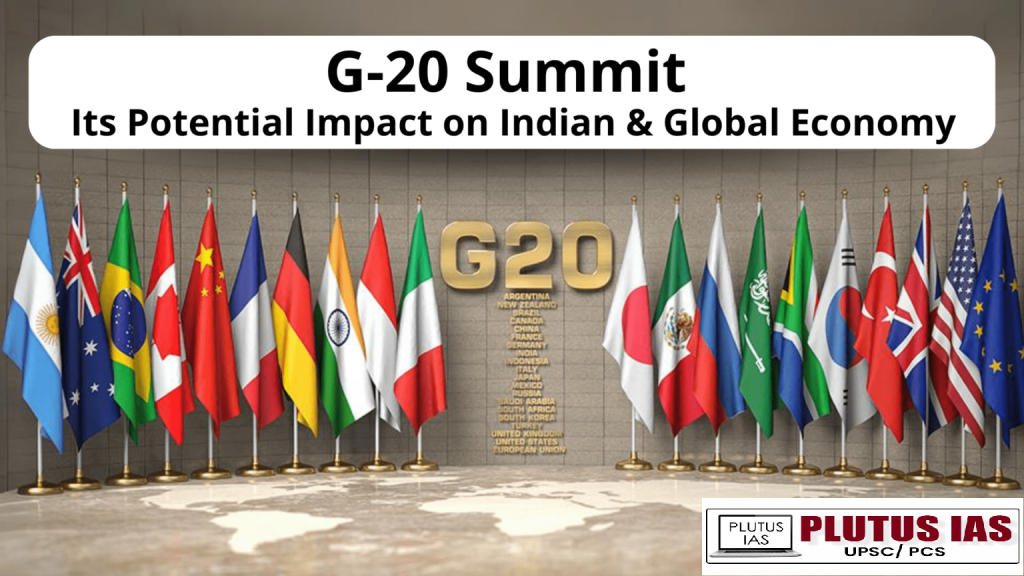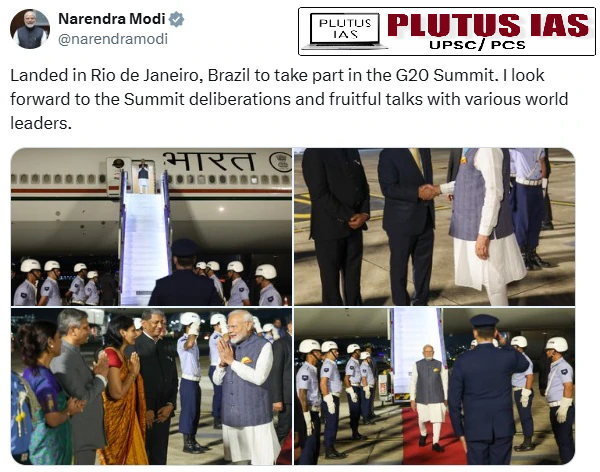18 Nov “Prime Minister Modi Arrives in Brazil for G20 Summit, Ready for Strategic Talks”
SYLLABUS MAPPING:
GS-2-International Relations-“Prime Minister Modi Arrives in Brazil for G20 Summit, Ready for Strategic Talks”
FOR PRELIMS:
“What are the key areas of focus for the G-20, and what is the G-20?”
FOR MAINS:
“What are the key challenges and opportunities for India in the context of the upcoming G20 Summit in Brazil? How can India contribute to the global agenda on issues like climate change, trade, and sustainable development?”
Why in the news?
Prime Minister Narendra Modi arrived in Rio de Janeiro, Brazil, on Monday to attend the 19th G20 Leaders’ Summit, set to take place on November 18 and 19. Upon his arrival, he expressed his eagerness to engage in discussions with global leaders and fruitful deliberations during the summit.
What is G-20?
The G-20, or Group of Twenty, is an international forum for governments and central bank governors from 19 major countries and the European Union. The group was created to bring together the world’s largest economies to discuss and coordinate policies on economic issues and address global challenges.
Key Features of the G-20:
Membership: The G-20 includes 19 individual countries and the European Union and African unions, representing both developed and emerging economies. The member countries are:
Argentina, Australia, Brazil, Canada, China, France, Germany, India, Indonesia, Italy, Japan, Mexico, Russia, Saudi Arabia, South Africa, South Korea, Turkey, the United Kingdom, the United States, and the European Union (EU) and South Africa.
Global Impact:
The G-20 represents about 85% of the world’s GDP, 75% of global trade, and two-thirds of the global population.
This makes the G-20 a powerful platform for addressing the most pressing global challenges, including economic crises, climate change, trade, health, and development.
History:
The G-20 was established in 1999 in response to the Asian Financial Crisis of 1997-98. Initially, it was a forum for Finance Ministers and Central Bank Governors to discuss global financial issues.
In the aftermath of the 2007-2008 Global Financial Crisis, the G-20 was elevated to the level of Heads of State and Government and became recognized as the “premier forum for international economic cooperation.”
Meetings and Summits:
The G-20 holds an annual summit where leaders (Heads of State or Government) of member countries meet to discuss major global issues. In addition, there are various meetings and discussions throughout the year involving finance ministers, central bank governors, and other officials.
The summit is hosted by the country holding the presidency, which rotates annually.
Key Areas of Focus:
Economic Cooperation: Promoting global economic stability, growth, and trade.
Climate Change: Addressing the global impact of environmental issues and seeking sustainable solutions.
Global Health: Managing health crises, such as pandemics (e.g., COVID-19), and strengthening healthcare systems.
Global Security: Fostering peace and stability through coordinated diplomatic and economic policies.
Digital Economy: Promoting technology and innovation for economic development.
Sustainable Development: Working towards the Sustainable Development Goals (SDGs), such as poverty reduction, education, and inclusive growth.
Two Tracks of Engagement:
Finance Track: Involves discussions among Finance Ministers and Central Bank Governors on global financial stability, economic policies, and financial systems.
Sherpa Track: Led by the Sherpas (personal representatives of the leaders), this track focuses on broader issues such as trade, development, and diplomacy.
Rotating Presidency:
The presidency of the G-20 rotates among its member countries. Each year, the country holding the presidency sets the agenda for the summit and hosts the key meetings.
The presidency also leads the troika, a group comprising the current, past, and future presidencies to ensure continuity and coordination in the G-20 process.

Evolutions of G-20 grouping as the main forum:
1. 1999: Establishment
Purpose: Created after the Asian Financial Crisis to bring together Finance Ministers and Central Bank Governors from major economies to discuss global economic issues.
Focus: Financial stability, policy coordination, and global economic issues.
2. 2008: Global Financial Crisis
Elevated to Heads of State/Government: In response to the Global Financial Crisis, the G-20 was upgraded to include leaders (not just economic ministers), making it the premier forum for international economic cooperation.
Washington Summit: World leaders coordinated responses to stabilize the global economy and financial markets.
3. 2009-2010: Post-Crisis Recovery
London Summit (2009): Coordinated global stimulus packages, bank reforms, and a commitment to reforming financial institutions like the IMF and World Bank.
G-20 Focus: Economic recovery, financial market regulation, and global financial reform.
4. 2011-2015: Expanding Agenda
Global Growth and Security: The G-20 began addressing global trade, job creation, climate change, sustainable development, and global security alongside economic coordination.
2014 Brisbane Summit: Focus on inclusive growth, addressing unemployment and promoting green growth.
5. 2016-2019: Broader Global Issues
Paris Agreement (2015): Increased focus on climate change and sustainability.
Hamburg Summit (2017): Focus on global trade, protectionism, and inclusive development.
Technological Transformation: Emphasis on digital economy and cybersecurity.
6. 2020: COVID-19 Response
Pandemic Response: The G-20 addressed global health challenges, coordinated efforts for vaccine distribution, and supported economic recovery with fiscal and monetary policies.
Global Coordination: Focus on health security, economic resilience, and support for vulnerable nations.
7. 2021-2023: Recovery and Sustainability
Sustainable Development Goals (SDGs): Emphasis on inclusive growth, climate change, and post-pandemic recovery.
India’s G-20 Presidency (2023): Prioritizing green development, inclusive growth, digital transformation, and the LiFE (Lifestyle for Environment) movement for sustainable living.
8. 2024: Future Agenda
Brazil’s G-20 Presidency: Likely to focus on inclusive growth, global security, sustainability, and technological transformation in a post-pandemic world.
Significance of g-20:
1. Global Economic Leadership: Represents 85% of global GDP and 75% of global trade, influencing the world economy and economic policies.
2. Crisis Management: Coordinates responses to global crises, such as the 2008 financial crisis and the COVID-19 pandemic, stabilizing the global economy.
3. Inclusive Growth: Focuses on poverty reduction, job creation, and economic inclusion, ensuring growth benefits all nations, especially developing ones.
4. Sustainable Development: Promotes green growth, climate action, and alignment of economic development with the Sustainable Development Goals (SDGs).
5. Global Trade and Investment: Supports open markets, reducing trade barriers, and boosting global trade and investment flows.
6. Multilateral Cooperation: Fosters global collaboration on economic policy, financial stability, and global governance reforms.
7. Shaping Global Standards: Sets key global policy frameworks on taxation, corporate governance, and the digital economy.
8. Global Security and Diplomacy: Addresses global security, health, and geopolitical challenges, promoting peace and stability.
Role of India at G-20:
1. Global Economic Influence: As a major emerging economy, India represents the Global South and advocates for inclusive growth and economic empowerment for developing nations.
2. Champion of Sustainability: Leading initiatives like the LiFE (Lifestyle for Environment) movement, India promotes climate action, green growth, and sustainable development.
3. Inclusive Growth: India pushes for policies addressing poverty, gender equality, job creation, and financial inclusion, ensuring benefits for all nations, especially developing ones.
4. Digital Transformation: Advocating for digital public infrastructure and tech-enabled development, India promotes financial inclusion and digital solutions for global challenges.
5. Global Health & Security: India has played a leading role in pandemic response, vaccine equity, and global health, and is a voice for peace and multilateralism.
6. Global Governance Reforms: India calls for more inclusive, fair global institutions, pushing for reforms in organizations like the IMF and World Bank.
7. Leadership in G-20 Presidency (2023): India’s theme, “Vasudhaiva Kutumbakam” (One Earth, One Family, One Future), emphasized sustainable development, inclusive growth, climate finance, and women empowerment.
What are the key issues with the G-20?
1. Lack of Binding Authority: G-20 decisions are non-binding, limiting enforcement of agreements, especially on climate action and trade.
2. Diverging Interests: Conflicting priorities between developed and developing nations make consensus difficult on issues like economic growth and climate justice.
3. Geopolitical Tensions: Rivalries (e.g., U.S.-China, EU-Russia) can hinder cooperation and affect global trade and security discussions.
4. Inequitable Representation: Smaller, poorer nations often feel marginalized, as the G-20 is dominated by major economies.
5. Slow Climate Action: Differences over climate finance and carbon reduction delay progress on global environmental goals.
6. Overlapping Institutions: The G-20’s work often overlaps with other bodies (like the UN or IMF), creating redundancy and inefficiency.
7. Power Imbalance: Wealthier countries (like the U.S. and China) dominate the decision-making process, limiting the influence of smaller nations.
8. No Enforcement Mechanisms: Lack of accountability structures makes it hard to ensure commitments are implemented.
Way forward:
1. Strengthen Enforcement: Establish mechanisms to hold countries accountable for climate, trade, and financial commitments.
2. Ensure Inclusivity: Provide greater representation for developing nations and include a consultative process for non-members.
3. Align Climate and Trade: Integrate green policies with trade frameworks to support sustainable economic growth.
4. Better Coordination: Work closely with other global institutions (e.g., UN, IMF) to avoid redundancy and ensure coherent governance.
5. Promote Digital Inclusion: Focus on digital infrastructure and financial inclusion for developing countries.
6. Expand the Agenda: Broaden focus beyond economics to address global health, security, and peace.
7. Strengthen Diplomacy: Use the G-20 as a platform for geopolitical dialogue and conflict resolution.
8. Drive Green Development: Increase climate finance and support sustainable technologies for inclusive growth. Establish mechanisms to hold countries accountable for climate, trade, and financial commitments.
Conclusion:
The G-20 plays a vital role in global economic cooperation but faces challenges like lack of binding authority, geopolitical tensions, and inequitable representation. To improve, the G-20 must strengthen enforcement mechanisms, ensure inclusivity, and align climate and trade policies. It should also expand its focus to include health, security, and digital inclusion.
Prelims Question:
Q. With reference to the “G20 Common Framework”, consider the following statements (UPSC Prelims 2022)
1. It is an initiative endorsed by the G20 together with the Paris Club.
2. It is an initiative to support low-income countries with unsustainable debt.
Which of the statements given above is/are correct?
A. 1 only
B. 2 only
C. Both 1 and 2
D. Neither 1 nor 2
Answer: C
(250 words, 15 marks)




No Comments